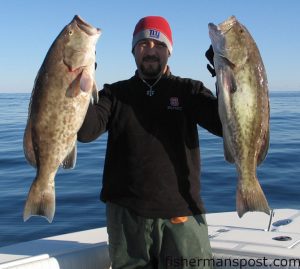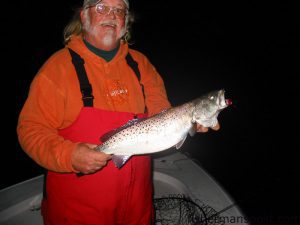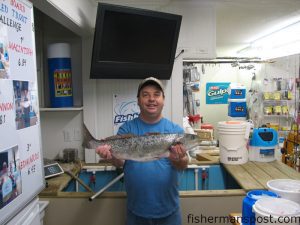Morehead City March 12, 2009
Matt, of Chasin Tails Outdoors, reports that they’ve seen some of the first solid blue water fishing of the year lately. Anglers are hooking up with some wahoo (in the 40 lb. range), dolphin, smaller yellowfin tuna, and king mackerel in the Gulf Stream. The action was solid around the Big Rock last week, and both trolled ballyhoo and Yo-Zuri Deep Divers were productive baits.
Over the next few weeks, warmer water moving into the area should really turn the yellowfins on. Trolling skirted and naked ballyhoo around the Yellowfin Hole, Swansboro Hole, and Big Rock should produce action with the tuna when they show up in earnest.
Bottom fishing has been excellent on the east side of Cape Lookout Shoals lately. The sea bass bite has been on fire around the Atlas Tanker and other similar structure, where smaller jigs and bottom rigs baited with squid will produce action.
Deeper structure like Chicken Rock is holding plenty of sea bass as well, along with red snapper, groupers, and other bottomfish. Squid, cigar minnows, and deep jigs are all drawing strikes from the bottom feeders.
Anglers are still finding hit-and-miss action with speckled trout at the Cape Lookout rock jetty at night, but the bite has been better in Slocum Creek and other creeks off the Neuse River. Rapala Subwalks have been the top baits at the jetty, and in the Neuse anglers are hooking up on MR 17 and 27 Mirrolures, Gulp baits, and Corkies.
There are still some trout in the creeks around Morehead, but the water needs to warm up a few degrees before they’re feeding aggressively, which should happen over the next week.
A few reds are holding in the creeks with the trout, and they’ve been falling for Gulp baits, spinnerbaits, and popping cork rigs worked slowly.
More reds are schooled up in the surf and on the flats between Cape Lookout and Swansboro, but it takes a warm day to get them in a feeding mood. Like the trout, the drum bite should take off over the coming weeks as the water temperature comes up.
Chopper bluefish and gray trout will be showing up soon as well. The choppers will be feeding everywhere from the nearshore reefs to the marshes, and they will take an interest in virtually any bait or lure. Anglers can target the gray trout by fishing green grubs or Tsunami Glass minnows near the bridges, or they can work Stingsilvers and spec rigs in the turning basin and inlet channel.
Whiting will be feeding alongside the grays in the basin and channel, and a spec rig tipped with fresh shrimp or Fish Bites will tempt strikes from both species.

Greg Kennedy with a pair of gag grouper he hooked while bottom fishing with cut mackerel. He was dropping on some structure in 100' of water off Atlantic Beach while fishing with Capt. Ken Mullen of Swell Rider Charters.
Paul, of Freeman’s Bait and Tackle, reports that dog sharks are providing the bulk of the action to bottom fishermen from the surf out to the nearshore structure. One surf angler did land a 6 lb. trout while casting Mirrolures last week.
Anglers are catching more trout while casting Mirrolures from shore at night at Cape Lookout.
The red drum bite has been better down south towards Hammocks Beach lately, without much word on action closer to home.
As soon as the surf temperatures reach the 58-60 degree mark (which should be in a couple weeks), anglers will begin to see more trout and red and black drum feeding in the surf as well as some pufferfish.
The chopper bluefish (8-10+ lbs.) have shown up the past few years in March as well, so anglers should be on the lookout for these eating machines.
Offshore, boats trolling the bluewater are starting to find action with wahoo and a few blackfin and yellowfin tuna. Ballyhoo rigged under skirted trolling lures are the top baits for these Gulf Stream predators.

Ted Page, from Harkers Island, with a trout caught in 3' of water near the Cape Lookout rock jetty on a MirrOlure. He was fishing with Capt. Charles Brown of Old Core Sound Guide Service.
Ken, of Swell Rider Sportfishing, reports that he’s finding an excellent sea bass bite at structure 20-25 miles offshore. The bass are plentiful and large, and they’re falling for squid on bottom rigs, as well hammered diamond jigs and large bucktails.
The cold water has put a damper on the grouper bite, but if the winds continue out of the south, some warm water should be pushed into the area soon. As soon as the water warms up, anglers can start prowling for red grouper at bottom structure in 120-135′ (around 30-35 miles out), and the bite is typically very good in the spring. Cut and live baits will tempt bites from the grouper, and anglers can also hook up while working vertical jigs.
Big amberjacks are schooled up on the offshore wrecks, and anglers looking for a serious battle should have no trouble convincing them to take a vertical jig.
The Gulf Stream bite is off to a slow start because the water’s still so cold in the area, but it should improve very soon.

